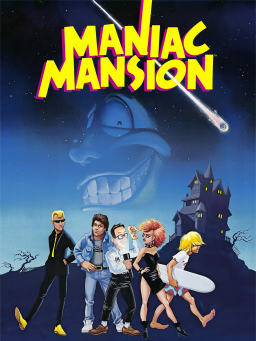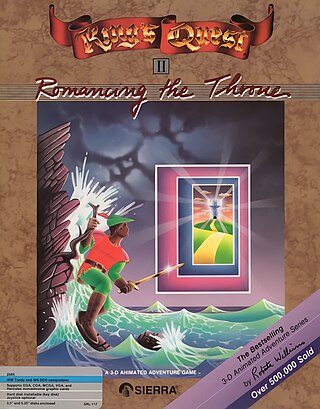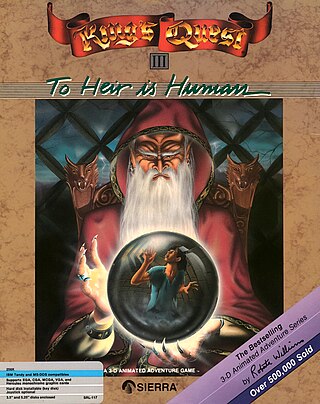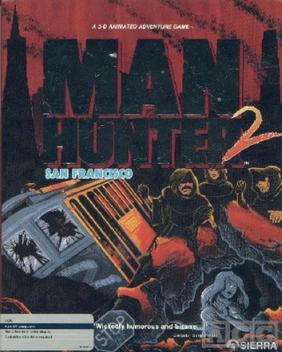
Maniac Mansion is a 1987 graphic adventure video game developed and published by Lucasfilm Games. It follows teenage protagonist Dave Miller as he attempts to rescue his girlfriend Sandy Pantz from a mad scientist, whose mind has been enslaved by a sentient meteor. The player uses a point-and-click interface to guide Dave and two of his six playable friends through the scientist's mansion while solving puzzles and avoiding dangers. Gameplay is non-linear, and the game must be completed in different ways based on the player's choice of characters. Initially released for the Commodore 64 and Apple II, Maniac Mansion was Lucasfilm Games' first self-published product.

King's Quest is a graphic adventure game series, released between 1980 and 2016 and created by the American software company Sierra Entertainment. It is widely considered a classic series from the golden era of adventure games. Following the success of its first installments, the series was primarily responsible for building the reputation of Sierra. Roberta Williams, co-founder and former co-owner of Sierra, designed all of the King's Quest games until the series' reboot in 2015.
Magnetic Scrolls was a British video game developer active between 1984 and 1990. A pioneer of audiovisually elaborate text adventure games, it was one of the largest and most acclaimed interactive fiction developers of the 1980s, and one of the "Big Two" with Infocom according to some.
The Adventure Game Interpreter (AGI) is a game engine developed by Sierra On-Line. The company originally developed the engine for King's Quest (1984), an adventure game that Sierra and IBM wished to market in order to attract consumers to IBM's lower-cost home computer, the IBM PCjr.
Manhunter or Man Hunter may refer to:

Mystery House is an adventure game released by On-Line Systems in 1980. It was designed, written and illustrated by Roberta Williams, and programmed by Ken Williams for the Apple II. Mystery House is the first graphical adventure game and the first game produced by On-Line Systems, the company which would evolve into Sierra On-Line. It is one of the earliest horror video games.

King's Quest: Quest for the Crown is an adventure game developed by Sierra On-Line and published originally for the IBM PCjr in 1984 and later for several other systems between 1984 and 1989. The game was originally titled King's Quest; the subtitle was added to the games box art in the 1987 re-release, but did not appear in the game.

King's Quest II: Romancing the Throne is the second installment in the King's Quest series of graphic adventure games by Sierra On-Line. It was originally released in 1985 for PC DOS/PCjr, and later made available for the Apple II/IIGS, Atari ST, and Amiga. It uses the same AGI game engine as King's Quest I: Quest for the Crown and features King Graham as the player character. The title is a spoof of the 1984 film Romancing the Stone.

King's Quest III: To Heir Is Human is the third installment in the King's Quest series of graphic adventure games developed and released by Sierra On-Line in 1986. The game was originally released for the Apple II and MS-DOS, and later ported to several other computer systems. It was the first title game in the series not to feature King Graham as the player character.

King's Quest IV: The Perils of Rosella is a graphic adventure game developed by Sierra On-Line for the MS-DOS, Amiga, Apple II, Apple IIGS, and Atari ST computers and released in 1988. The player takes on the role of Princess Rosella, daughter of King Graham of Daventry and the twin sister of Gwydion/Alexander, who must save her father and a good fairy and destroy an evil witch. Critically acclaimed, it was one of the first games for IBM PC compatibles to support a sound card.

Gold Rush! is a graphic adventure video game designed by Doug and Ken MacNeill and originally released by Sierra On-Line in 1988.

Leisure Suit Larry Goes Looking for Love (in Several Wrong Places) is the second game in the Leisure Suit Larry series of graphical adventure games, designed by Al Lowe and published by Sierra On-Line in 1988. Like its predecessor, Leisure Suit Larry in the Land of the Lounge Lizards, it was developed for multiple platforms, including MS-DOS, Atari ST and Amiga. It utilizes Sierra's Creative Interpreter (SCI0) engine, featuring 16-color EGA graphics and a mouse-based interface for movement. The story continues the exploits of Larry Laffer, who becomes stranded on a tropical island during an ill-fated vacation.

Leisure Suit Larry in the Land of the Lounge Lizards is a graphic adventure game, developed by Sierra On-Line, and published in 1987. It was developed for the MS-DOS and the Apple II and later ported to the Amiga, Atari ST, Apple IIGS, Mac, and Tandy Color Computer 3. It utilizes the Adventure Game Interpreter (AGI) engine. In 1991, Sierra released a remake titled Leisure Suit Larry 1: In the Land of the Lounge Lizards for MS-DOS, Mac, and Amiga. This version used the Sierra's Creative Interpreter (SCI) engine, featuring 256 colors and a point-and-click, icon-driven user interface.

Space Quest: Chapter I – The Sarien Encounter is a graphic adventure game, created by Scott Murphy and Mark Crowe, and released in October 1986 by Sierra On-Line. It is the first game in the Space Quest series, and sees players assume the role of a lowly janitor on a research ship, who becomes involved in stopping an alien race using a new form of technology for evil purposes.

Manhunter 2: San Francisco is a post-apocalyptic adventure game designed by Barry Murry, Dave Murry, and Dee Dee Murry of Evryware and published in 1989 by Sierra On-Line. It is the sequel to Manhunter: New York, developed by the same authors.

Police Quest: In Pursuit of the Death Angel is a 1987 police procedural adventure video game developed and published by Jim Walls and Sierra On-Line. Police Quest follows police officer Sonny Bonds as he investigates a drug cartel in the town of Lytton, California.
An adventure game is a video game genre in which the player assumes the role of a protagonist in an interactive story, driven by exploration and/or puzzle-solving. The genre's focus on story allows it to draw heavily from other narrative-based media, such as literature and film, encompassing a wide variety of genres. Most adventure games are designed for a single player, since the emphasis on story and character makes multiplayer design difficult. Colossal Cave Adventure is identified by Rick Adams as the first such adventure game, first released in 1976, while other notable adventure game series include Zork, King's Quest, Monkey Island, Syberia, and Myst.
There have been several King's Quest fangames both original and retellings/remakes of the original games that have been released by various developers.

Sierra Championship Boxing is a boxing video game developed by Evryware and published by Sierra On-Line in 1983. Versions were released for Apple II, Commodore 64, IBM PC compatibles, and Mac.














